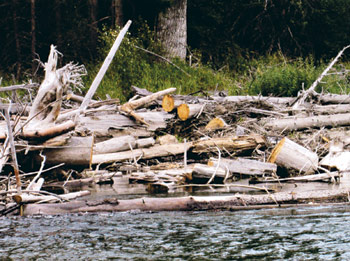In late September, Steve Wingard embarked on a nine-day canoe trip down the Upper Swan River. Originating from the Mission Mountains, it’s an elaborate float that meanders through dense timber stands and sharp turns, forcing boaters to maneuver a multitude of obstacles, most commonly, logjams. It’s also a prized source of large trout that attracts anglers from across the country.
Within a few days, Wingard’s exhilaration sullied as he came across a prevalent and illegal situation that, he says, raises concerns about bull trout spawning grounds and damages to the river and its banks.
At several points along the river, Wingard discovered logjams and other fallen trees that were cut and cleared from the passage and away from its banks. One particular section was significantly altered by chainsaws, according to Wingard.
Logjams and other woody debris can provide key habitat for bull trout and other fish species, but they can also present a nuisance and unsafe obstacles for anglers and floaters.
Beyond affecting fish, removing logjams can lead to changes in the river channel or erosion issues on public and private property. Some landowners have even posted signs along the Upper Swan trying to deter the type of log cutting that Wingard ran across.
In order to cut away logjams or undertake any other work in or near a stream on public or private land, individuals must undergo a review process and obtain authorization through a 310 permit, in accordance with the Montana Natural Streambed and Land Preservation Act. A conservation district representative and a Montana Fish, Wildlife and Parks biologist will conduct an on-site inspection during the review to ensure that the proposed work does not damage wildlife habitat, fish species or the integrity of the river.
Wingard contacted the Lake County Conservation District, the office tasked with issuing 310 permits on the Upper Swan, and officials told him none had been issued for cutting along that section of river, according to Wingard.
Administrators with the conservation district were attending an annual conference last week and could not be reached for comment.
Wingard also contacted FWP and inquired about the cutting.
“Right now, people are doing what they want and FWP and law enforcement are looking the other way,” he said.
FWP fisheries biologist Leo Rosenthal acknowledged the cutting of some logjams along the Upper Swan in an interview last week, but downplayed the significance.
“The Swan River has a lot of woody debris. Over time folks have cut their way through certain parts that represent safety hazards,” Rosenthal said. “It’s not something I’m super familiar with.”
He added, “In my experience, it’s always been pretty minimal. The amount of cutting that folks have done is pretty insignificant.”
 |
|
A section of the upper Swan River where log jams were ilegally cut apart by individuals. | Courtesy photo |
Rosenthal acknowledged that a large amount of clearing on the river could present problems to fish habitat, and that FWP encourages individuals to undergo proper review before any work is done.
“We do encourage folks to go through that process so we can evaluate anytime people will take wood out of the stream or propose any stream channel changes,” he said. “It would be the best case scenario to evaluate all of these all of the time.”
Rosenthal and other FWP biologists recently finished the annual survey of bull trout redds in the Swan drainage and found reduced levels yet again. The basin-wide redd count has averaged 555 during the last 19-year period, from 1995 through 2013. The 2013 basin-wide count of 335 is similar to the previous three years, and is approximately 40 percent below the 19-year average. Nonnative lake trout are considered a large factor in the bull trout population’s decline, and gillnetting operations continue on Swan Lake to try and reduce the lake trout population.
Wingard remains concerned about prevalent cutting along the Swan River. He contends that everyone and anyone who plans to change the habitat should do so legally.
“It’s a delicate area and it’s also a habit of a protected species (bull trout),” he said. “You have to tread lightly in places like that. Going about it legally is important. If you cut people loose, they’ll go over the top as far as cutting.”